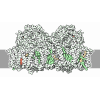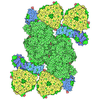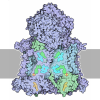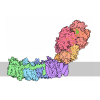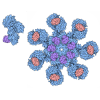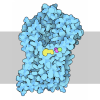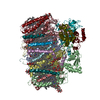+ Open data
Open data
- Basic information
Basic information
| Entry | Database: PDB / ID: 9g6g | ||||||||||||||||||||||||
|---|---|---|---|---|---|---|---|---|---|---|---|---|---|---|---|---|---|---|---|---|---|---|---|---|---|
| Title | Semi-active PSII dimer from native Peak4 PSII dimers | ||||||||||||||||||||||||
 Components Components |
| ||||||||||||||||||||||||
 Keywords Keywords | PHOTOSYNTHESIS / PSII / native intermediate / photodamage / PSII assembly | ||||||||||||||||||||||||
| Function / homology |  Function and homology information Function and homology informationphotosystem II oxygen evolving complex / photosystem II assembly / oxygen evolving activity / photosystem II stabilization / photosystem II reaction center / photosystem II / oxidoreductase activity, acting on diphenols and related substances as donors, oxygen as acceptor / photosynthetic electron transport chain / photosystem II / response to herbicide ...photosystem II oxygen evolving complex / photosystem II assembly / oxygen evolving activity / photosystem II stabilization / photosystem II reaction center / photosystem II / oxidoreductase activity, acting on diphenols and related substances as donors, oxygen as acceptor / photosynthetic electron transport chain / photosystem II / response to herbicide / extrinsic component of membrane / chlorophyll binding / plasma membrane-derived thylakoid membrane / photosynthetic electron transport in photosystem II / : / phosphate ion binding / photosynthesis, light reaction / photosynthesis / respiratory electron transport chain / electron transfer activity / protein stabilization / iron ion binding / heme binding / metal ion binding Similarity search - Function | ||||||||||||||||||||||||
| Biological species |   Thermosynechococcus vestitus BP-1 (bacteria) Thermosynechococcus vestitus BP-1 (bacteria) | ||||||||||||||||||||||||
| Method | ELECTRON MICROSCOPY / single particle reconstruction / cryo EM / Resolution: 2.2 Å | ||||||||||||||||||||||||
 Authors Authors | Zhao, Z. / Vercellino, I. / Nixon, P.J. / Sazanov, L.A. | ||||||||||||||||||||||||
| Funding support |  United Kingdom, 2items United Kingdom, 2items
| ||||||||||||||||||||||||
 Citation Citation |  Journal: To Be Published Journal: To Be PublishedTitle: Semi-active PSII dimer from the Peak4 PSII dimers Authors: Zhao, Z. / Vercellino, I. / Nixon, P.J. / Sazanov, L.A. | ||||||||||||||||||||||||
| History |
|
- Structure visualization
Structure visualization
| Structure viewer | Molecule:  Molmil Molmil Jmol/JSmol Jmol/JSmol |
|---|
- Downloads & links
Downloads & links
- Download
Download
| PDBx/mmCIF format |  9g6g.cif.gz 9g6g.cif.gz | 1.1 MB | Display |  PDBx/mmCIF format PDBx/mmCIF format |
|---|---|---|---|---|
| PDB format |  pdb9g6g.ent.gz pdb9g6g.ent.gz | 993.3 KB | Display |  PDB format PDB format |
| PDBx/mmJSON format |  9g6g.json.gz 9g6g.json.gz | Tree view |  PDBx/mmJSON format PDBx/mmJSON format | |
| Others |  Other downloads Other downloads |
-Validation report
| Summary document |  9g6g_validation.pdf.gz 9g6g_validation.pdf.gz | 9.9 MB | Display |  wwPDB validaton report wwPDB validaton report |
|---|---|---|---|---|
| Full document |  9g6g_full_validation.pdf.gz 9g6g_full_validation.pdf.gz | 10.1 MB | Display | |
| Data in XML |  9g6g_validation.xml.gz 9g6g_validation.xml.gz | 195.3 KB | Display | |
| Data in CIF |  9g6g_validation.cif.gz 9g6g_validation.cif.gz | 268.6 KB | Display | |
| Arichive directory |  https://data.pdbj.org/pub/pdb/validation_reports/g6/9g6g https://data.pdbj.org/pub/pdb/validation_reports/g6/9g6g ftp://data.pdbj.org/pub/pdb/validation_reports/g6/9g6g ftp://data.pdbj.org/pub/pdb/validation_reports/g6/9g6g | HTTPS FTP |
-Related structure data
| Related structure data |  51101MC M: map data used to model this data C: citing same article ( |
|---|---|
| Similar structure data | Similarity search - Function & homology  F&H Search F&H Search |
- Links
Links
- Assembly
Assembly
| Deposited unit | 
|
|---|---|
| 1 |
|
- Components
Components
-Photosystem II ... , 17 types, 30 molecules ABbCcDdHhIiJjKkLlMmOTtUXxYyZza
| #1: Protein | Mass: 39762.309 Da / Num. of mol.: 1 / Source method: isolated from a natural source Source: (natural)   Thermosynechococcus vestitus BP-1 (bacteria) Thermosynechococcus vestitus BP-1 (bacteria)References: UniProt: P0A444, photosystem II | ||||||||||||||||||||||||||||||
|---|---|---|---|---|---|---|---|---|---|---|---|---|---|---|---|---|---|---|---|---|---|---|---|---|---|---|---|---|---|---|---|
| #2: Protein | Mass: 56656.457 Da / Num. of mol.: 2 / Source method: isolated from a natural source Source: (natural)   Thermosynechococcus vestitus BP-1 (bacteria) Thermosynechococcus vestitus BP-1 (bacteria)References: UniProt: Q8DIQ1 #3: Protein | Mass: 50287.500 Da / Num. of mol.: 2 / Source method: isolated from a natural source Source: (natural)   Thermosynechococcus vestitus BP-1 (bacteria) Thermosynechococcus vestitus BP-1 (bacteria)References: UniProt: Q8DIF8 #4: Protein | Mass: 39388.156 Da / Num. of mol.: 2 / Source method: isolated from a natural source Source: (natural)   Thermosynechococcus vestitus BP-1 (bacteria) Thermosynechococcus vestitus BP-1 (bacteria)References: UniProt: Q8CM25, photosystem II #7: Protein | Mass: 7358.754 Da / Num. of mol.: 2 / Source method: isolated from a natural source Source: (natural)   Thermosynechococcus vestitus BP-1 (bacteria) Thermosynechococcus vestitus BP-1 (bacteria)References: UniProt: Q8DJ43 #8: Protein/peptide | Mass: 4438.255 Da / Num. of mol.: 2 / Source method: isolated from a natural source Source: (natural)   Thermosynechococcus vestitus BP-1 (bacteria) Thermosynechococcus vestitus BP-1 (bacteria)References: UniProt: Q8DJZ6 #9: Protein/peptide | Mass: 4105.908 Da / Num. of mol.: 2 / Source method: isolated from a natural source Source: (natural)   Thermosynechococcus vestitus BP-1 (bacteria) Thermosynechococcus vestitus BP-1 (bacteria)References: UniProt: P59087 #10: Protein/peptide | Mass: 5028.083 Da / Num. of mol.: 2 / Source method: isolated from a natural source Source: (natural)   Thermosynechococcus vestitus BP-1 (bacteria) Thermosynechococcus vestitus BP-1 (bacteria)References: UniProt: Q9F1K9 #11: Protein/peptide | Mass: 4299.044 Da / Num. of mol.: 2 / Source method: isolated from a natural source Source: (natural)   Thermosynechococcus vestitus BP-1 (bacteria) Thermosynechococcus vestitus BP-1 (bacteria)References: UniProt: Q8DIN8 #12: Protein/peptide | Mass: 3981.673 Da / Num. of mol.: 2 / Source method: isolated from a natural source Source: (natural)   Thermosynechococcus vestitus BP-1 (bacteria) Thermosynechococcus vestitus BP-1 (bacteria)References: UniProt: Q8DHA7 #13: Protein | | Mass: 29637.443 Da / Num. of mol.: 1 / Source method: isolated from a natural source Source: (natural)   Thermosynechococcus vestitus BP-1 (bacteria) Thermosynechococcus vestitus BP-1 (bacteria)References: UniProt: P0A431 #14: Protein/peptide | Mass: 3906.738 Da / Num. of mol.: 2 / Source method: isolated from a natural source Source: (natural)   Thermosynechococcus vestitus BP-1 (bacteria) Thermosynechococcus vestitus BP-1 (bacteria)References: UniProt: Q8DIQ0 #15: Protein | | Mass: 15030.986 Da / Num. of mol.: 1 / Source method: isolated from a natural source Source: (natural)   Thermosynechococcus vestitus BP-1 (bacteria) Thermosynechococcus vestitus BP-1 (bacteria)References: UniProt: Q9F1L5 #17: Protein/peptide | Mass: 4322.226 Da / Num. of mol.: 2 / Source method: isolated from a natural source Source: (natural)   Thermosynechococcus vestitus BP-1 (bacteria) Thermosynechococcus vestitus BP-1 (bacteria)References: UniProt: Q9F1R6 #18: Protein/peptide | Mass: 5039.143 Da / Num. of mol.: 2 / Source method: isolated from a natural source Source: (natural)   Thermosynechococcus vestitus BP-1 (bacteria) Thermosynechococcus vestitus BP-1 (bacteria)References: UniProt: Q8DJI1 #19: Protein | Mass: 6766.187 Da / Num. of mol.: 2 / Source method: isolated from a natural source Source: (natural)   Thermosynechococcus vestitus BP-1 (bacteria) Thermosynechococcus vestitus BP-1 (bacteria)References: UniProt: Q8DHJ2 #20: Protein | | Mass: 39777.301 Da / Num. of mol.: 1 / Source method: isolated from a natural source Source: (natural)   Thermosynechococcus vestitus BP-1 (bacteria) Thermosynechococcus vestitus BP-1 (bacteria)References: UniProt: P0A444, photosystem II |
-Cytochrome b559 subunit ... , 2 types, 4 molecules EeFf
| #5: Protein | Mass: 9580.840 Da / Num. of mol.: 2 / Source method: isolated from a natural source Source: (natural)   Thermosynechococcus vestitus BP-1 (bacteria) Thermosynechococcus vestitus BP-1 (bacteria)References: UniProt: Q8DIP0 #6: Protein/peptide | Mass: 5067.900 Da / Num. of mol.: 2 / Source method: isolated from a natural source Source: (natural)   Thermosynechococcus vestitus BP-1 (bacteria) Thermosynechococcus vestitus BP-1 (bacteria)References: UniProt: Q8DIN9 |
|---|
-Protein , 1 types, 1 molecules V
| #16: Protein | Mass: 18046.943 Da / Num. of mol.: 1 / Source method: isolated from a natural source Source: (natural)   Thermosynechococcus vestitus BP-1 (bacteria) Thermosynechococcus vestitus BP-1 (bacteria)References: UniProt: P0A386 |
|---|
-Sugars , 2 types, 27 molecules 
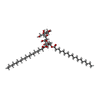

| #30: Sugar | ChemComp-LMT / #35: Sugar | ChemComp-DGD / |
|---|
-Non-polymers , 18 types, 1161 molecules 

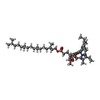


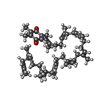
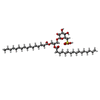


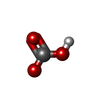
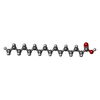
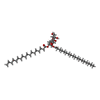
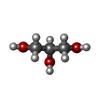
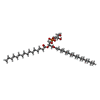



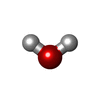

















| #21: Chemical | | #22: Chemical | #23: Chemical | ChemComp-CLA / #24: Chemical | ChemComp-PHO / #25: Chemical | ChemComp-BCR / #26: Chemical | ChemComp-PL9 / #27: Chemical | ChemComp-SQD / #28: Chemical | ChemComp-LFA / #29: Chemical | ChemComp-OEX / | #31: Chemical | #32: Chemical | ChemComp-PLM / #33: Chemical | ChemComp-LMG / #34: Chemical | ChemComp-GOL / | #36: Chemical | ChemComp-LHG / #37: Chemical | #38: Chemical | #39: Chemical | ChemComp-CA / | #40: Water | ChemComp-HOH / | |
|---|
-Details
| Has ligand of interest | Y |
|---|---|
| Has protein modification | Y |
-Experimental details
-Experiment
| Experiment | Method: ELECTRON MICROSCOPY |
|---|---|
| EM experiment | Aggregation state: PARTICLE / 3D reconstruction method: single particle reconstruction |
- Sample preparation
Sample preparation
| Component | Name: Semi-active PSII dimer with one PSII lacking extrinsic subunits Type: COMPLEX Details: This semi-active complex is a PSII dimer with one monomer containing the extrinsic subunits, while the other monomer lacks the extrinsic subunits. This structure was obtained from the Peak4 ...Details: This semi-active complex is a PSII dimer with one monomer containing the extrinsic subunits, while the other monomer lacks the extrinsic subunits. This structure was obtained from the Peak4 PSII, which was eluted as the fourth fraction in the ion exchange chromatography after the nickel affinity pull-down. Entity ID: #1-#20 / Source: NATURAL |
|---|---|
| Molecular weight | Experimental value: NO |
| Source (natural) | Organism:   Thermosynechococcus vestitus BP-1 (bacteria) / Cellular location: thylakoid membrane Thermosynechococcus vestitus BP-1 (bacteria) / Cellular location: thylakoid membrane |
| Buffer solution | pH: 6.5 Details: 20 mM MES pH 6.5, 2.5 mM MgCl2, 2.5 mM CaCl2, 7 mM MgSO4, 0.03% DDM, 0.05% CHAPS |
| Specimen | Conc.: 0.3 mg/ml / Embedding applied: NO / Shadowing applied: NO / Staining applied: NO / Vitrification applied: YES |
| Specimen support | Details: The grids were glow-discharged for 5 sec at 25 mA before freezing. Grid material: COPPER / Grid mesh size: 300 divisions/in. / Grid type: Quantifoil R0.6/1 |
| Vitrification | Instrument: FEI VITROBOT MARK IV / Cryogen name: ETHANE / Humidity: 100 % / Chamber temperature: 277.15 K |
- Electron microscopy imaging
Electron microscopy imaging
| Experimental equipment |  Model: Titan Krios / Image courtesy: FEI Company |
|---|---|
| Microscopy | Model: TFS KRIOS |
| Electron gun | Electron source:  FIELD EMISSION GUN / Accelerating voltage: 300 kV / Illumination mode: FLOOD BEAM FIELD EMISSION GUN / Accelerating voltage: 300 kV / Illumination mode: FLOOD BEAM |
| Electron lens | Mode: BRIGHT FIELD / Nominal magnification: 81000 X / Nominal defocus max: 2000 nm / Nominal defocus min: 600 nm |
| Specimen holder | Cryogen: NITROGEN / Specimen holder model: FEI TITAN KRIOS AUTOGRID HOLDER |
| Image recording | Electron dose: 80 e/Å2 / Film or detector model: GATAN K3 BIOQUANTUM (6k x 4k) / Num. of grids imaged: 1 / Num. of real images: 9173 |
- Processing
Processing
| EM software |
| |||||||||||||||||||||||||||||||||||||||||||||||||||||||||||||||||||||||||||||||||||||||||||||||||||||||||||||||||||||||
|---|---|---|---|---|---|---|---|---|---|---|---|---|---|---|---|---|---|---|---|---|---|---|---|---|---|---|---|---|---|---|---|---|---|---|---|---|---|---|---|---|---|---|---|---|---|---|---|---|---|---|---|---|---|---|---|---|---|---|---|---|---|---|---|---|---|---|---|---|---|---|---|---|---|---|---|---|---|---|---|---|---|---|---|---|---|---|---|---|---|---|---|---|---|---|---|---|---|---|---|---|---|---|---|---|---|---|---|---|---|---|---|---|---|---|---|---|---|---|---|---|
| CTF correction | Type: PHASE FLIPPING AND AMPLITUDE CORRECTION | |||||||||||||||||||||||||||||||||||||||||||||||||||||||||||||||||||||||||||||||||||||||||||||||||||||||||||||||||||||||
| Particle selection | Num. of particles selected: 5900000 | |||||||||||||||||||||||||||||||||||||||||||||||||||||||||||||||||||||||||||||||||||||||||||||||||||||||||||||||||||||||
| 3D reconstruction | Resolution: 2.2 Å / Resolution method: FSC 0.143 CUT-OFF / Num. of particles: 272215 / Symmetry type: POINT | |||||||||||||||||||||||||||||||||||||||||||||||||||||||||||||||||||||||||||||||||||||||||||||||||||||||||||||||||||||||
| Atomic model building | Protocol: FLEXIBLE FIT / Space: REAL | |||||||||||||||||||||||||||||||||||||||||||||||||||||||||||||||||||||||||||||||||||||||||||||||||||||||||||||||||||||||
| Atomic model building | 3D fitting-ID: 1 / Source name: PDB / Type: experimental model
|
 Movie
Movie Controller
Controller





 PDBj
PDBj